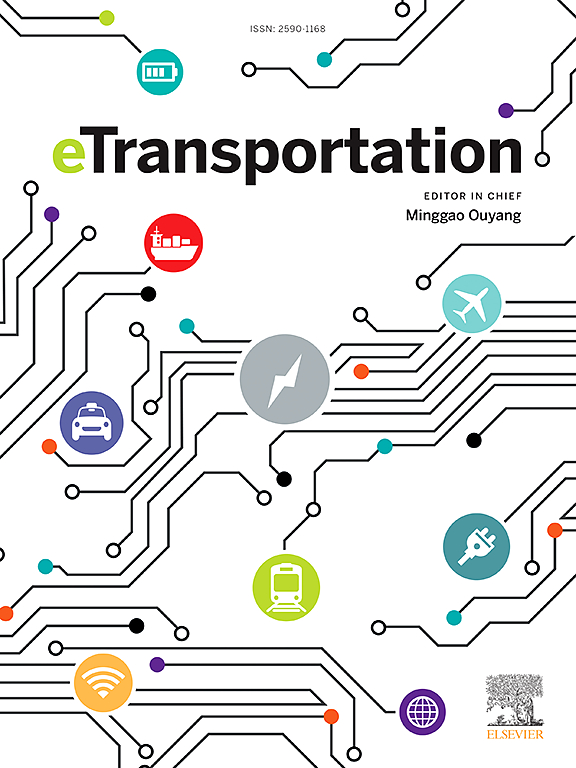高性能耐用聚合物电解质膜燃料电池多孔电极多物理场建模的挑战与展望
IF 17
1区 工程技术
Q1 ENERGY & FUELS
引用次数: 0
摘要
开发高性能、耐用的聚合物电解质膜燃料电池(PEMFCs)是实现大规模商业化的关键。对先进多孔电极设计中的多物理现象的全面洞察为雄心勃勃的目标提供了动力。建模是理解多物理场转移不可缺少的工具,为电极结构设计和材料结构选择提供了一条有前途的途径。尽管取得了进展,建模界仍然面临着重大的挑战,包括过度简化、耦合复杂特征的困难、不明确的物理知识以及不可避免的差异。这一观点强调了多孔电极建模的现状,确定了存在的挑战,并探讨了关键技术和潜在对策的未来方向。具体来说,比较了复杂多孔电极微观结构的宏观尺度、中尺度和微观尺度模型的特点和局限性,包括有序结构、中孔碳载体、各种催化剂结构等。针对这些挑战提出了下一代多孔电极设计的潜在解决方案。此外,提出并讨论了推进跨尺度、全形态和全耦合建模的三种替代方法,包括逐层物理性质传递、界面数据传递和直接数值模拟以及数据驱动辅助跨尺度建模,这些方法有望在可预见的未来得到评估和验证。本文章由计算机程序翻译,如有差异,请以英文原文为准。
Challenges and perspectives towards multi-physics modeling for porous electrode of ultrahigh performance durable polymer electrolyte membrane fuel cells
The development of ultrahigh-performance, durable polymer electrolyte membrane fuel cells (PEMFCs) is crucial for achieving large-scale commercialization. A comprehensive insight into multi-physics phenomena within advanced porous electrode designs provide motivation for the ambitious targets. Modeling is an indispensable tool in multi-physics transfer understanding and offers a promising pathway for electrode structural designs and material architecture selections. Despite the progress, the modeling community continues to face significant challenges, including oversimplification, difficulties in coupling complex features, unclear physical knowledge, and unavoidable discrepancies. This perspective highlights the current status of porous electrode modeling, identifies ongoing challenges, and explores future directions for key technologies and potential countermeasures. Specifically, the characteristics and limitations of macro-scale, meso-scale, and micro-scale models regarding intricate porous electrode microstructures are compared, including ordered structure, mesoporous carbon support, various catalyst architectures, etc. Potential solutions to these challenges are proposed for the next generation of porous electrode designs. Furthermore, three alternatives to advancing cross-scale, full-morphology, and full-coupling modeling are developed and discussed, including layer-by-layer physical property transfer, interfacial data transfer and direct numerical simulation, and data-driven assisted cross-scale modeling, which are expected to be evaluated and validated in the foreseeable future.
求助全文
通过发布文献求助,成功后即可免费获取论文全文。
去求助
来源期刊

Etransportation
Engineering-Automotive Engineering
CiteScore
19.80
自引率
12.60%
发文量
57
审稿时长
39 days
期刊介绍:
eTransportation is a scholarly journal that aims to advance knowledge in the field of electric transportation. It focuses on all modes of transportation that utilize electricity as their primary source of energy, including electric vehicles, trains, ships, and aircraft. The journal covers all stages of research, development, and testing of new technologies, systems, and devices related to electrical transportation.
The journal welcomes the use of simulation and analysis tools at the system, transport, or device level. Its primary emphasis is on the study of the electrical and electronic aspects of transportation systems. However, it also considers research on mechanical parts or subsystems of vehicles if there is a clear interaction with electrical or electronic equipment.
Please note that this journal excludes other aspects such as sociological, political, regulatory, or environmental factors from its scope.
 求助内容:
求助内容: 应助结果提醒方式:
应助结果提醒方式:


